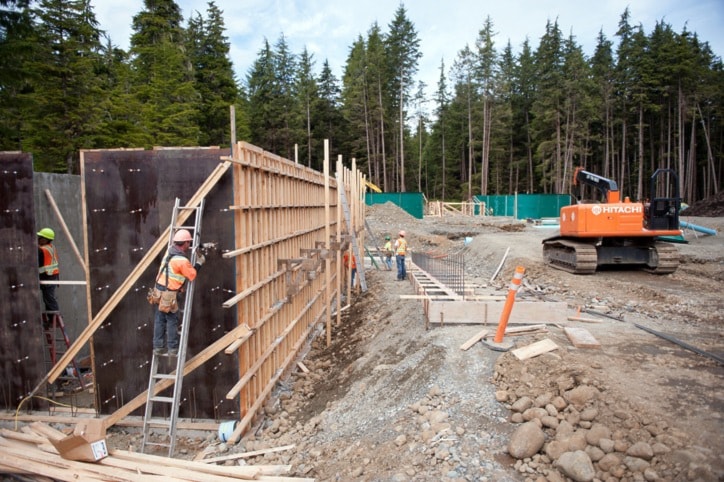PORT McNEILL—If the construction project under way near the Nimpkish River crossing of Highway 19 looks like nothing that has come before, that’s because it is.
“This is the first in Canada,” said Jackie Hildering, community liaison for the ‘Namgis closed containment Atlantic salmon farm pilot project, which is scheduled for completion this fall.
The $7.25 million project aims to demonstrate Atlantic salmon can be raised economically while removing the environmental impacts associated with traditional, open-net pen salmon farming.
The project, which will employ a recirculation aquaculture system (RAS), is one of seven worldwide at various stages of production or development, and the only one in Canada.
“There’s no doubt we can do it,” said Cathal Dineen, who was hired as project manager after spending 15 years in primarily RAS aquaculture projects in Ireland, Iceland and the U.K. “The technology is there, it’s just at what cost?
“We believe at this point we’re very close to producing the fish at a cost that’s comparable to conventional fish-farming methods. And these systems are getting more efficient all the time.”
The project under construction south of the Nimpkish will be an indoor facility consisting of five, 500 cubic metre grow-out tanks for Atlantic salmon, as well as a 250 cubic metre quarantine tank.
Water will enter from a freshwater aquifer on the ‘Namgis-owned site. Effluent will be run through underground pipes to a treatment plant, while solids will be filtered out and stored on site, with the potential to be used for compost or fertilizer.
One of the most unique features of the facility is its biofilter, which will be filled with millions of bacteria that digest and remove metabolites from the fish waste before the water is recirculated back into the grow-out tanks.
“In fact, we’re growing two different species here,” said Dineen. “We’re growing fish, and we’re growing the bacteria. And they depend on each other to survive.”
Building at the site is expected to be completed in November, and the biofilter will be “seeded” with bacteria beginning December in a process Dineen said would take 4-6 weeks.
The first smolts are scheduled to enter the quarantine tank next January.
“And a year later, the fish will be eaten,” said Hildering.
Once at full production the plant could harvest 470 tonnes of fish per year, or nine tonnes a week on a year-round basis.
Because all inputs and outputs from the system can be controlled, fish can be grown to market size in half the time as in conventional fish farms, Dineen said.
And if this pilot project proves economically viable, as many as four more such modules could be added.
Initially, smolts will be purchased from Marine Harvest, and processing and transportation will be contracted.
“The ultimate goal of this project is to have our own hatchery, our own processing plant, our own everything,” said Hildering.
Editor's note: The print version of this article, which published in the Our Coast supplement to the July 26 edition of the Gazette, provided an incorrect amount for the federal grant contributed toward this project.
The total funding secured for the construction and operation of the Project is in fact $7.25 million. The funders are: Sustainable Development Technology Canada ($2.65m); DFO’s Aquaculture Innovation and Market Access Program ($800K); Aboriginal Affairs Canada ($257K); and the Coast Sustainability Trust ($113K). The federal funding has been leveraged with matching funding of $3.17m provided by the Tides Canada’s Salmon Aquaculture Innovation Fund. For more information on the 'Namgis Closed Containment Atlantic Salmon Farm see http://www.namgis.bc.ca/CCP/Pages/default.aspx.
